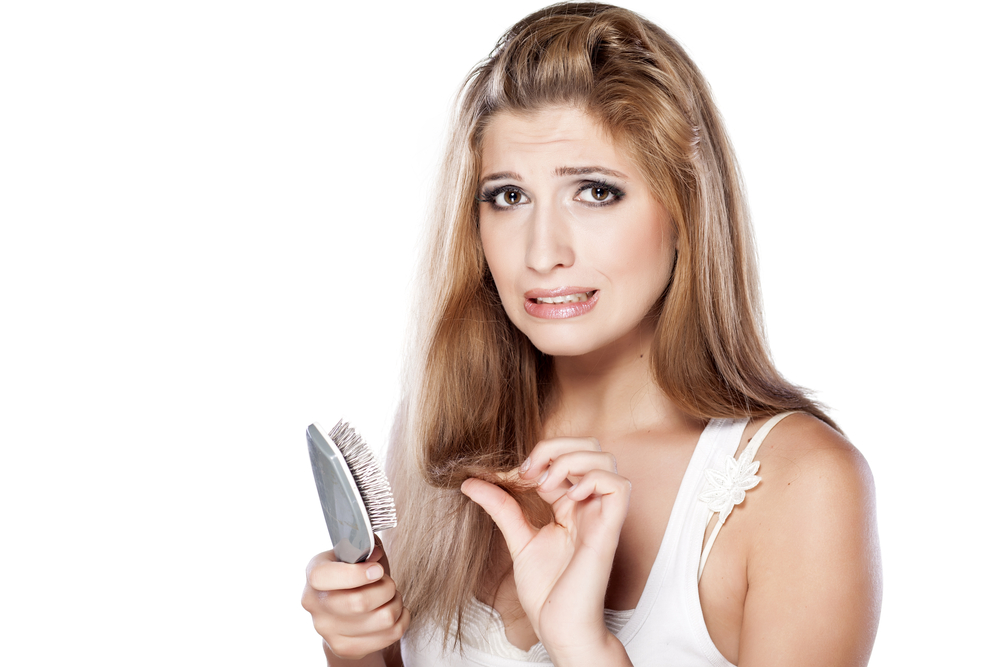It is true that more men suffer hair loss than women do but this does not mean hair loss is not common among women. In India, a large number of women battle this problem every day. For them, losing their crowning glory is disturbing, especially if they are still young. Hair is considered to be an important part of your personality, and women therefore have a tough time dealing with hair loss.
Reasons for hair loss may range from stress and malnutrition to heredity and disease. But you need to understand that hair loss is common, and 50% of women experience it at some time or the other in their lives. [1] Let’s have a look at the forms and treatment options for hair loss in women.
Forms of hair loss in women
Androgenetic alopecia: Women suffering from this condition have thinning of hair all over the scalp. This condition can be caused due to a number of factors, including high androgen index contraceptive pills, ovarian cysts, menopause, pregnancy etc. [2]
Telogen effluvium: Sometimes, your body goes through a traumatic situation like a severe infection, a major surgery, extreme stress or child birth. Under such situations, 90% of your growing hair shifts into what is known as the resting phase, and this can continue for as long as 3 months. At such times, telogen effluvium begins, and handfuls of hair may come off. [3]
Anagen effluvium: This occurs when your hair follicles are severely abused, such as during chemotherapy. [4]
Alopecia areata: If you are experiencing patchy hair shedding all of a sudden, you are actually experiencing an inflammatory reaction called alopecia areata. [5]
Traction alopecia: This condition is the result of localized trauma to the shafts and follicles over time, such as through tight hair styles like tight ponytails, braiding, extensions and cornrows. [6]
Hair loss can be caused due to a number of factors, including the following:
- Malnutrition or crash dieting
- Contraceptive pills
- Tight hairstyles
- Extreme stress
- Hormonal imbalances, such as menopause or pregnancy
- Deficiency of iron
- Major surgery
- Certain medications
- Genetics
Treatment options for hair loss in women
- Anti-androgen medications: If you do not respond to OTC minoxidil, you may be prescribed anti-androgen medicines known to stimulate hair growth and slow down hair loss. They work by inhibiting the male hormones that are responsible for aggravating hair loss. [7]
- Corticosteroids: These medicines contain steroids that suppress your immune system and prevent damage to your hair follicles. These are injected into the bald areas of your scalp; steroids stimulate hair growth and stop hair loss. Some of the common corticosteroids include betamethasone, hydrocortisone and mometasone.[8]
- Low Level Light Therapy or LLLT: In this therapy, low level laser or LEDs are used for reducing hair loss and stimulating hair growth. If the correct coherence, dosimetric parameters and wavelength are maintained, this therapy can be effective in treating hair loss in women. [9]
- Minoxidil administration: Irrespective of the cause of your hair loss, Minoxidil can be the best treatment option for you. This OTC drug is available in the form of liquid formulas or mousse. It has been proven to slow hair loss and also stimulate growth of hair. It is most effective if you are less than 40 years of age, and if you have recently started losing hair. Minoxidil liquid may be applied on your scalp twice a day for minimum 4 months before you can see any results. Having said that, it is best to seek your dermatologist’s advice both on the nature and duration of treatment.Now that you have understood the causes, forms and treatment options of hair loss in women, you can gain control over the health of your hair, and feel better.
References:
[1]. Hair Loss: MedlinePlus. 2016.Hair Loss: MedlinePlus. [ONLINE] Available at: https://www.nlm.nih.gov/medlineplus/hairloss.html. [Accessed 10 February 2016].
[2]. Androgenetic alopecia – Genetics Home Reference. 2016.Androgenetic alopecia – Genetics Home Reference [ONLINE] Available at: http://ghr.nlm.nih.gov/condition/androgenetic-alopecia. [Accessed 10 February 2016].
[3]. Telogen effluvium. – PubMed – NCBI. 2016.Telogen effluvium. – PubMed – NCBI. [ONLINE] Available at: http://www.ncbi.nlm.nih.gov/pubmed/12190639.[Accessed 10 February 2016].
[4]. Anagen effluvium. – PubMed – NCBI. 2016.Anagen effluvium. – PubMed – NCBI. [ONLINE] Available at: http://www.ncbi.nlm.nih.gov/pubmed/23974578. [Accessed 10 February 2016].
[5]. Questions and Answers About Alopecia Areata. 2016.Questions and Answers About Alopecia Areata. [ONLINE] Available at: http://www.niams.nih.gov/Health_Info/Alopecia_Areata. [Accessed 10 February 2016].
[6]. Traction Alopecia. 2016.Traction Alopecia. [ONLINE] Available at: http://www.ncbi.nlm.nih.gov/pmc/articles/PMC2096823. [Accessed 10 February 2016].
[7]. Antiandrogen therapy for skin and hair disease. – PubMed – NCBI. 2016.Antiandrogen therapy for skin and hair disease. – PubMed – NCBI. [ONLINE] Available at: http://www.ncbi.nlm.nih.gov/pubmed/16677962. [Accessed 10 February 2016].
[8]. Alopecia areata: a new treatment plan. 2016.Alopecia areata: a new treatment plan. [ONLINE] Available at: http://www.ncbi.nlm.nih.gov/pmc/articles/PMC3149478/. [Accessed 10 February 2016].
[9]. Types of hair loss and treatment options, including the novel low-level light therapy and its proposed mechanism. – PubMed – NCBI. 2016.Types of hair loss and treatment options, including the novel low-level light therapy and its proposed mechanism. – PubMed – NCBI. [ONLINE] Available at: http://www.ncbi.nlm.nih.gov/pubmed/20689478. [Accessed 10 February 2016].
















